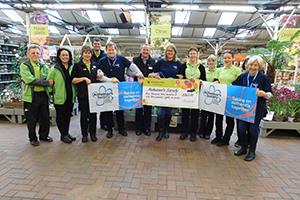As the days get warmer, customers are spending hours and hours out in the garden – which means investing in new outdoor living equipment. Relaxing outside on the grass with a cold bottle of beer, maybe with a BBQ sizzling away — a blissful afternoon by anyone’s standards! But if your customers suffer from allergies, particularly pollen allergies like hay fever, then the idea of relaxing out in the garden over summer in an allergy-free garden could seem like an unachievable dream. In dry or windy conditions, pollen spores spread quickly and aggravate hay fever symptoms. What seems like a great idea on paper quickly turns into a sunny afternoon of sneezing and coughing.
With 44% of British adults suffering from one allergy or more, enabling customers to create allergy-free gardens could be a huge benefit. Join compost supplier Compost Direct as we look at how to market allergy-free gardens…
Do some plants emit less pollen?
Pollen is a microscopic grain substance that transports male plant DNA to the female part of the flower. There are many different types of pollen, each with its own characteristics such as size, shape, and surface texture. Although most pollen species can cause an allergic reaction, some pollen species are more problematic than other. For example, many hay fever sufferers are allergic to grass pollen. This is because non-flowering plants, such as grass, have to dispel a large amount of pollen in order to pollenate other plants. On the other hand, flowering plants do not need to emit as much pollen as insects will be attracted to the flower and carry the pollen to another plant.
Allergy-free garden hacks
Let’s take a look now at which garden picks produce little-to-no pollen.
Tackle the lawn
Grass is a problem for nearly all hay fever sufferers. 95 per cent of hay fever sufferers have their allergies triggered by grass pollen. The best way to deal with it is to simply remove it — either by having an artificial lawn, or replacing with decking, for example. This could be an outdoor display at your garden centre, marketed with signage about allergy-free gardens.
The more petals, the better 
As a basic rule, if a plant has been grown to be a double-petal or super-double-petal, it will have lost a few male stamens on the way. Essentially, gaining more petals gives the plant less pollen, so point this out on your double-petal varieties.
Female plants
Another trick is to ensure there are a lot of female plants in the garden. Female plants don’t produce pollen, they capture it. Plants with berries or fruits are not completely male, so be sure to opt for these types of plants.
Plus, if your customers have a male tree in the garden, placing female varieties of that tree nearby will help catch the pollen it emits.
Insect-pollinated plants
Lean towards insect-pollinated plants rather than wind-pollinated plants. Insect-pollinated plants don’t release pollen into the air, so your customers are less likely to come into contact with it. Some examples of insect-pollinated plants to stock are:
• Roses
• Snapdragons
• Yarrow
• Apple tree
Hedges to filter
Bordering a garden with female varieties of hedges essentially builds a filter all around the home that will capture pollen drifting towards your customers’ residence on the wind.
Timing is everything:
Customers can minimise their exposure to pollen even further by considering the hours they are spending outdoors. They should try to stay indoors early morning (5am–10am) when plants are releasing pollen. Again, they should head indoors for the evening as pollen in the air begins to drift towards the ground again at this time. This is a great opportunity to market fire pits, candles, outdoor lighting etc alongside the plants and trees which will help reduce hay fever symptoms.




